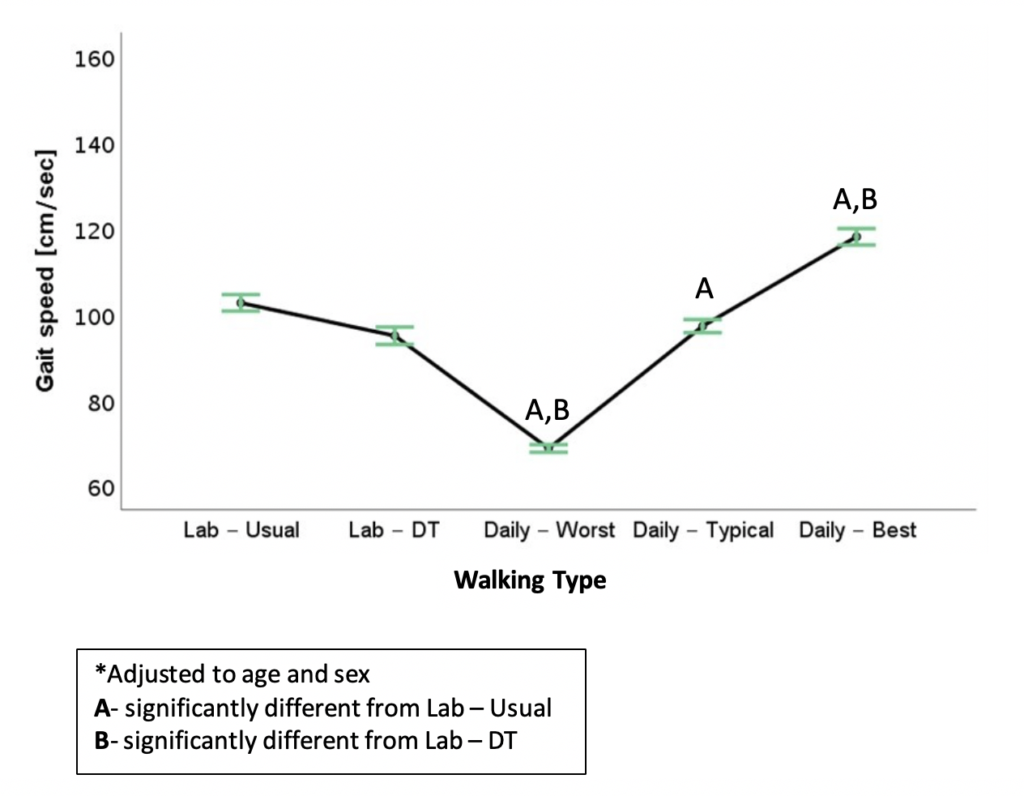Among older adults, gait impairments threaten functional independence. Gait decline is associated with, and predictive of, numerous adverse health outcomes. These include falls, mobility impairment, cognitive decline, dementia, and even mortality. Traditional laboratory and clinic-based evaluations of gait have provided important insights but are limited by the “snapshot” nature in an environment that can only attempt to mimic every-day settings. Wearable technology enables continuous monitoring of gait in free-living environments and represents an ecologically valid, complementary way of measuring gait function. Previous findings show that in-lab and real-world measures of gait differ but the how and why is unclear. As a step towards a better understanding of these gaps, we directly compared in-lab usual-walking and dual-task walking (i.e., while serially subtracting 3 from a predefined 3-digit number) to daily-living measures of gait.
One hundred and fifty older adults with a history of falling participated in the study. Gait speed was derived from an accelerometer placed on the lower back during both daily-living and in-lab settings. A histogram of all 30 seconds daily-living walking bouts was determined for each subject. Then, each subject’s typical (percentile 50, median), worst (percentile 10) and best (percentile 90) values over the week were determined and compared to gait speed during in-lab usual-walking and dual-task walking.
As expected, in-lab gait speed was slower during dual-task walking (94.7±22.2 cm/s), compared to usual-walking (100.5±21.5 cm/s). In-lab gait speed during usual-walking was significantly different compared to the worst (68.5±10.1 cm/s), typical (96.5±17.9 cm/s) and best (117.2±22.5 cm/s) daily-living values. Gait speed during in-lab dual-task walking was similar to typical daily-living values (see Figure 1). ICC assessment and Bland-Altman plots indicated that in-lab values do not reliably reflect the daily-walking values.
These results suggest that gait values measured during relatively long daily-living walking bouts are more comparable to those obtained in the lab during a challenging dual-task condition. Still, the values measured in the lab do not reliably reflect daily-living measures and potentially reflect different constructs of what a person can do versus what they actually do at home. This suggests that an older adult’s typical daily-life gait cannot be estimated by simply measuring walking in a structured, laboratory setting. Dual-tasking partially accounts for the differences between in-lab and free-living walking but additional work is needed to better understand the multiple factors that contribute to these differences and their impact on assessment and prediction of changes in mobility in older adults.

Figure: Effect of setting on gait speed
Publication
Hillel, Inbar, et al. “Is every-day walking in older adults more analogous to dual-task walking or to usual walking? Elucidating the gaps between gait performance in the lab and during 24/7 monitoring.” European Review of Aging and Physical Activity 16.1 (2019): 6. doi: 10.1186/s11556-019-0214-5
About the Author

Inbar Hillel
Center for the Study of Movement, Cognition and Mobility, Neurological Institute, Tel Aviv Sourasky Medical Center, Tel Aviv Israel
Copyright
© 2019 by the author. Except as otherwise noted, the ISPGR blog, including its text and figures, is licensed under a Creative Commons Attribution-ShareAlike 4.0 International License. To view a copy of this license, visit https://creativecommons.org/licenses/by-sa/4.0/legalcode.
ISPGR blog (ISSN 2561-4703)
Are you interested in writing a blog post for the ISPGR website? If so, please email the ISGPR Secretariat with the following information:
- First and Last Name
- Institution/Affiliation
- Paper you will be referencing


